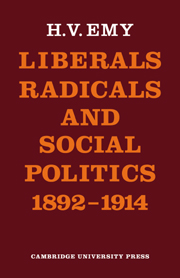Book contents
5 - The Liberals in office 1906–9
Published online by Cambridge University Press: 04 May 2010
Summary
IN PARLIAMENT
While Liberals generally were agreed upon the negative character of the causes, if not the implications of their victory, in the new parliament Masterman for one was ‘surprised and delighted’ at ‘the real demand for large measures of social reform … found throughout the whole of the great Radical majority’. Massingham too considered Radicalism ‘the most powerful force in the party’, and while Radicals and Labour remained united, he foresaw a difficulty for the government in keeping pace with the impatient spirit of its supporters. Chiozza Money thought the Liberals could boast of more avowed collectivists than the L.R.C., a fact which received a certain grudging admission amongst Labour. Graham Wallas named over a score of Liberals of whom he had high hopes, and pleaded for an efficient use of the parliamentary majority, for a proper consideration of legislative priorities to avoid congestion, a plea in which he was supported by Keir Hardie. Snowden also considered that ‘among the new Liberal members there are quite a considerable number of earnest young men who are more in sympathy with the Labour and socialist movement than they are with the Whiggism which is so largely represented in the Government’, and he hinted at an alliance with the ‘socialistic Liberals.’ Gladstone's own analysis of the majority was in more sober tones: ‘The most striking thing … is the preponderance of the Centre Liberals.’
- Type
- Chapter
- Information
- Liberals, Radicals and Social Politics 1892–1914 , pp. 142 - 188Publisher: Cambridge University PressPrint publication year: 1973



